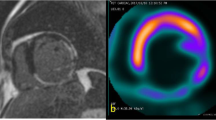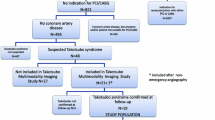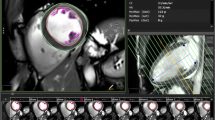Abstract
Objectives
Fluorine-18 fluorodeoxyglucose (FDG) SPECT has emerged as an alternative to dedicated PET imaging. However, it remains uncertain whether FDG SPECT is an as accurate for viability assessment as FDG PET in patients with severely reduced left ventricular function. The aim of the study was to assess the diagnostic accuracy of FDG SPECT in a head-to-head comparison with FDG PET, and divide the patients according to the severity of left ventricular dysfunction.
Methods
A total of 47 patients, with a history of myocardial infarction underwent FDG/perfusion (99mTc-sestamibi or201T1) SPECT as well as FDG/13N-ammonia PET. The patients were divided into 2 subgroups based on the left ventricular ejection fraction (LVEF) (35% cutoff). The left ventricular myocardium was divided into 13 segments, and each segment was classified as viable or scar using a semi-quantitative scoring system based on defect severity and the presence or absence of perfusion-FDG mismatch.
Results
Of the 47 patients studied, 23 had LVEF < 35% (low LVEF group; mean 25 ± 7%), whereas the remaining 24 had LVEF > 35% (high LVEF group; mean 47 ± 6%). In the low LVEF group, 213 segments (71%) were dysfunctional, as compared to 102 (33%) in the high LVEF group. The agreement for detection of viability between PET and SPECT in the low LVEF group was 82% (kappa 0.63), which was not different from the agreement in the high LVEF group (85%, kappa 0.66, p = 0.42 versus low LVEF group).
Conclusions
The results indicate that FDG SPECT can be used for tissue viability assessment regardless of the severity of left ventricular dysfunction.
Similar content being viewed by others
References
Tillisch J, Brunken R, Marshall R, Schwaiger M, Mandelkern M, Phelps M, et al. Reversibility of cardiac wall-motion abnormalities predicted by positron tomography.N Engl J Med 1986; 314: 884–888.
vom-Dahl J, Eitzman DT, Al-Aouar ZR, Kanter HL, Hicks RJ, Deeb GM, et al. Relation of regional function, perfusion, and metabolism in patients with advanced coronary artery disease undergoing surgical revascularization.Circulation 1994; 90: 2356–2366.
Tamaki N, Kawamoto M, Tadamura E, Magata Y, Yonekura Y, Nohara R, et al. Prediction of reversible ischemia after revascularization. Perfusion and metabolic studies with positron emission tomography.Circulation 1995; 91:1697–1705.
Bax JJ, Visser FC, van Lingen A, Huitink JM, Kamp O, van Leeuwen GR, et al. Feasibility of assessing regional myo-cardial uptake of18F-fluorodeoxyglucose using single photon emission computed tomography.Eur Heart J 1993; 14:1675–1682.
Bax JJ, Visser FC, Blanksma PK, Veening MA, Tan ES, Willemsen TM, et al. Comparison of myocardial uptake of fluorine-18-fluorodeoxyglucose imaged with PET and SPECT in dyssynergic myocardium.J Nucl Med 1996; 37:1631–1636.
Bax JJ, Cornel JH, Visser FC, Fioretti PM, van Lingen A, Huitink JM, et al. Prediction of improvement of contractile function in patients with ischemic ventricular dysfunction after revascularization by fluorine-18 fluorodeoxyglucose single-photon emission computed tomography.J Am Coll Cardiol 1997; 30: 377–383.
Haas F, Haehnel CJ, Picker W, Nekolla S, Martinoff S, Meisner H, et al. Preoperative positron emission tomo-graphic viability assessment and perioperative and postoperative risk in patients with advanced ischemic heart disease.J Am Coll Cardiol 1997; 30: 1693–1700.
Matsunari I, Kanayama S, Yoneyama T, Matsudaira M, Nakajima K, Taki J, et al. Electrocardiographic-gated dual-isotope simultaneous acquisition SPET using18F-FDG and99mTc-sestamibi to assess myocardial viability and function in a single study.Eur J Nucl Med Mol Imaging 2005; 32:195–202.
Matsunari I, Kanayama S, Yoneyama T, Matsudaira M, Nakajima K, Taki J, et al. Myocardial distribution of (18)F-FDG and (99m)Tc-sestamibi on dual-isotope simultaneous acquisition SPET compared with PET.Eur J Nucl Med Mol Imaging 2002; 29: 1357–1364.
Burt RW, Perkins OW, Oppenheim BE, Schauwecker DS, Stein L, Wellman HN, et al. Direct comparison of fluorine-18-FDG SPECT, fluorine-18-FDG PET and rest thallium-201 SPECT for detection of myocardial viability.J Nucl Med 1995; 36: 176–179.
Chen EQ, Maclntyre WJ, Go RT, Brunken RC, Saha GB, Wong CY, et al. Myocardial viability studies using fluorine-18-FDG SPECT: a comparison with fluorine-18-FDG PET.J Nucl Med 1997; 38: 582–586.
Srinivasan G, Kitsiou AN, Bacharach SL, Bartlett ML, Miller-Davis C, Dilsizian V. [18F]fluorodeoxyglucose single photon emission computed tomography: can it replace PET and thallium SPECT for the assessment of myocardial viability?Circulation 1998; 97: 843–850.
Fukuchi K, Katafuchi T, Fukushima K, Shimotsu Y, Toba M, Hayashida K, et al. Estimation of myocardial perfusion and viability using simultaneous99mTc-tetrofosmin—FDG collimated SPECT.J Nucl Med 2000; 41: 1318–1323.
Slart RH, Bax JJ, de Boer J, Willemsen AT, Mook PH, Oudkerk M, et al. Comparison of (99m)Tc-sestamibi/ (18)FDG DISA SPECT with PET for the detection of viability in patients with coronary artery disease and left ventricular dysfunction.Eur J Nucl Med Mol Imaging 2005;32: 972–979.
Knuuti MJ, Nuutila P, Ruotsalainen U, Saraste M, Harkonen R, Ahonen A, et al. Euglycemic hyperinsulinemic clamp and oral glucose load in stimulating myocardial glucose utilization during positron emission tomography.J Nucl Med 1992; 33: 1255–1262.
Delbeke D, Videlefsky S, Patton JA, Campbell MG, Martin WH, Ohana I, Sandler MP. Rest myocardial perfusion/ metabolism imaging using simultaneous dual-isotope acquisition SPECT with technetium-99m-MIBI/fluorine-18-FDG.J Nucl Med 1995; 36: 2110–2119.
Chua T, Kiat H, Germano G, Maurer G, van Train K, Friedman J, Berman D. Gated technetium-99m sestamibi for simultaneous assessment of stress myocardial perfusion, postexercise regional ventricular function and myocardial viability. Correlation with echocardiography and rest thallium-201 scintigraphy.J Am Coll Cardiol 1994; 23:1107–1114.
Cwajg E, Cwajg J, Keng F, He ZX, Nagueh S, Verani MS. Comparison of global and regional left ventricular function assessed by gated-SPECT and 2-D echocardiography.Rev Port Cardiol 2000; 19Suppl 1:139–146.
Author information
Authors and Affiliations
Corresponding author
Rights and permissions
About this article
Cite this article
Matsunari, I., Bax, J.J., Blanksma, P.K. et al. Effect of left ventricular function on diagnostic accuracy of FDG SPECT. Ann Nucl Med 20, 51–56 (2006). https://doi.org/10.1007/BF02985591
Received:
Accepted:
Issue Date:
DOI: https://doi.org/10.1007/BF02985591




